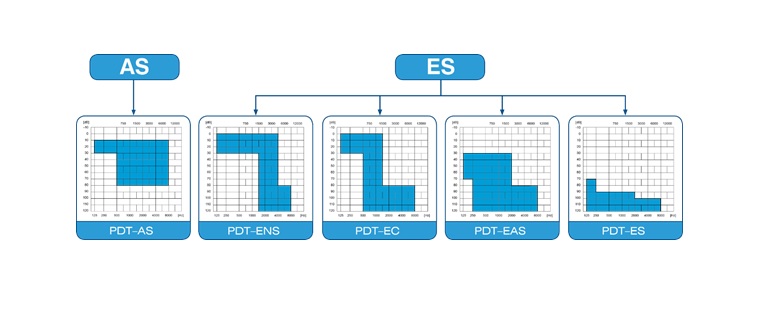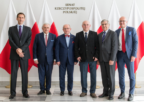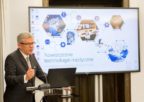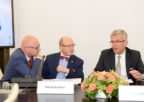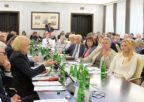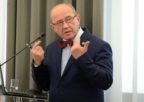„Modern medical technologies and their impact on a daily clinical practice in Polish healthcare” has been a topic of a conference which took place in the Senate on 7 June 2016. Its originators had been the Speaker of Polish Senate Stanisław Karczewski and Prof. Henryk Skarżyński, Chairman of the Clinical Science Committee of Polish Academy of Sciences, Deputy Chairman of the Main Council of the Research Institutes and Director of the Institute of Physiology and Pathology of Hearing. In the conference participated politicians, eminent Polish physicians and journalists. Discussion had been opened by Waldemar Kraska, Chairman of the Senate Committee for Health; its moderators were Prof. Henryk Skarżyński and Mariusz Gujski, a journalist.
– This debate is aimed at presenting the selected innovations of Polish science and medicine and their impact on clinical practice. – said Speaker Stanisław Karczewski. – In this debate we want to consider to what degree we have managed, or not, to influence the level of medical services through achievements of scientists, teams and specialized institutions. (…) Medical progress, also in Poland, is enormous. You – said Speaker Stanisław Karczewski addressing the participants of the conference – are the leaders of this medical and technological race. But in the first place I think about a patient, because these newest solutions are in fact dedicated to our patients.
– I thank all, who have accepted our invitation and want to share their experiences with others. – Said Prof. Skarżyński welcoming speakers, representatives of media and guests. – This formula of meetings in not a new thing, the Clinical Science Committee has organized earlier similar debates with media participation. It is an excellent way to promote achievements of Polish science – added Prof. Skarżyński.
At the Conference Prof. Skarzynski presented a lecture titled „Partial Deafness Treatment – Polish School in World’s Science’ referring to 25th anniversary of Polish program of treatment of deafness and 20th anniversary of the Institute of Physiology and Pathology of Hearing. We enclose hereunder its extensive abstract.
Treatment of total deafness, congenital or acquired, with cochlear implants is an only chance to return patient to the world of sounds at any age. For over 40 years more than 200 thousand people have been helped using this treatment method. Application of cochlear implants in treatment of a classic partial deafness is a matter of the last 15 years. This principal treatment method has been introduced to world’s medicine by Prof. Henryk Skarżyński in 2002. This breakthrough had been preceded by studies conducted in the Institute of Physiology and Pathology of Hearing since 1997, related to preservation of the smallest residual hearing which can be supplemented with ‘new hearing’ obtained through cochlear implant. Development of this therapy concept and surgical method was a huge challenge, engaging otosurgeons and doctors of other specialties, clinical engineers and rehabilitation specialists.
Preservation concerned initially residual hearing, and since 2002 good low frequency hearing allowing patient before cochlear implantation to understand speech at the level of 5 – 16%. When their hearing is complemented with electrical stimulation these patients can develop full speech understanding and freedom in contacts with environment. This groundbreaking approach in science and medicine means that electric stimulation of a partially working inner ear is possible, which is not fully in line with a travelling wave theory for which Prof. G. von Bekesy received a Nobel Prize in 1961.
For 13 years the Institute of Physiology and pathology of Hearing has been performing daily the largest in the world number of hearing improving surgeries.
Criteria of a school in modern science are well known. There must be a leader or a group of leaders with a documented large scientific and clinical output, multi-specialist team of collaborators, presence of a possibly large group of international experts and partners representing leading world’s centers in expedient. An effect of work of leaders, collaborators and partners should be a significant, best the largest number of original publications and presentations on the most important continental and global scientific congresses in a given field of medicine and science. A material experience confirming the results and role of a school is a large, preferably the largest clinical material supported by a long term follow-up. An important indicator confirming the importance and role of a school are the distinctions, awards, quotations and opinions in a given field of science. Treatment of partial deafness – as a Polish school in world’s science fulfills all these conditions.
Initiated by Prof. H. Skarżyński in 1997 program of treatment combining an acoustic hearing with an electric hearing obtained through cochlear implantation, has assembled in the Institute of Physiology and pathology of hearing a group of more than 50 specialists: physicians, clinical engineers, psychologists, educators, speech and language therapists and technicians, who have all contributed to the scientific output if the ‘school’ through their research, clinical, teaching and organizational work. Leaders of the Institute’s program have authored several hundreds of publications and presentations in collaboration with 52 scientists from all continents from 34 leading countries globally. In the years 2000-2016 the team of the Institute has presented, with and without international partners, 2135 presentations only on international and continental series of congresses in otorhinolaryngology, audiology and related fields in Europe, Asia, Australia, both Americas and Africa. Simultaneously the same group has published 1465 papers reporting all aspects related to diagnostics, treatment and rehabilitation of the partial deafness. Subsequent studies, analyses and reports of longitudinal follow-up studies concern the largest in the global medicine group of 317 patients with partial deafness.
Speaking about the ‘Polish School’ it is worth highlighting several important actions and dates.
In 2000, on the Congresses in Antwerp and Berlin, Prof. H. Skarzynski and dr. A. Lorens have presented first reports about the quality of preserved non-functional residual hearing. Preservation of that small level of hearing after cochlear implantation provides an important assistance for the process of rehabilitation of hearing and speech. It means also that the inner ear structures are preserved in the unchanged condition, therefore that ear can be useful later, and when new, innovative, even better hearing improving technologies are developed and implemented. At the same time implementation of the partial deafness treatment with a cochlear implant on the present stage of development of technology and medicine still enables sustained development of hearing, speech and one or more languages. A second milestone, related to the typical partial deafness, has been the first surgery in an adult performed by Prof. H. Skarzynski in 2002. That patient had been able preoperatively to perceive sounds well in the low frequency range up to 500 Hz, with total deafness in all other frequencies. Successful preservation of the low-frequency hearing complemented with electric stimulation for reception of the rest of frequency range provided an incentive for the dynamic development of research and clinical practice in that direction. After 2 years of follow-up of all implanted adult patients, in 2004 Prof. H. Skarzynski had performed the first in the world child with partial deafness. Moreover, in 2009 he had for the first time in the world presented and in 2010 published a paper presenting Skarzynski’s concept of treatment in relation to various groups of patients with the partial deafness. It involved inclusion of the 3 principal criteria:
- a) application of the Skarzynski’s surgical method of 6 steps,
- b) selection and implementation of the surgical approach to the inner ear through the round window membrane as the most physiological way of entry to the cochlea,
- c) availability of different types of elastic electrode arrays, including Cochlear SRA array designed by Skarzynski.
Further works on the program of treatment of partial deafness had been continued in the Institute of Physiology and Pathology of Hearing simultaneously with popularization of this method in different forms on different continents, presenting its principles on all major global and continental scientific conferences. These presentations were supplemented with ‘live’ demonstration surgeries performed by H. Skarzynski in Asia, Europe and America. Simultaneously, for the needs of spreading clinical knowledge and providing an optimal training program, the Institute has started a series of international surgical training workshops called Window Approach Workshops in 2007. Since its beginning till 2016 the Workshops had already 24 editions. Until 2016 there have been more than 3500 ear surgeons from all over the world involved in this program of hands-on training, patient assessment and demonstration surgeries. Since 2010, the Institute participates actively in the LION Live International Otolaryngology Network yearly global broadcast, with H. Skarzynski presenting surgeries of partial deafness treatment with various types of electrodes and implant systems. These live surgical broadcasts include each year presentations of surgeries from several centers from the whole world simultaneously – from Australia, Asia, Europe, both Americas. They attract each time an audience numbering from several thousand to several tens of thousands participants.
Presentation of the Polish school of treatment of partial deafness had been preceded by a huge work and contribution of an international group of leading specialists involved in implementation of the program of treatment of total deafness. The program had been spearheaded by such eminent researchers and surgeons as: W. House and T. Balkany in the USA, Ch. Chouard in France, K. Burian in Austria, E. Lehnhardt in Germany, G. Clark and W. Gibson in Australia. Many of these leaders had participated in conferences organized by the Institute in Poland.
Practical preparations for initiation of the program of treatment of deafness in Poland had been started by Prof. H. Skarzynski with the support of the Foundation of Medical Development ‘Homo-Homini’ in 1991. He performed first surgeries of treatment of total deafness in Poland on 16 and 17 July 1992.
Further progress of the Polish program of treatment of total deafness has resulted in a gradual widening of indications for treatment of deafness with cochlear implants. It provided a foundation for the program of treatment of partial deafness. In its initial stage, in the years 2002-2008 the program involved combining the electric hearing with the preserved natural hearing up to the level of 500 Hz. In following years electrical complementation was extended to the level of 750 Hz and 1000 Hz. The top achievement had been the first in the world publication in 2014 and 2015, in which Skarzynski et al. had presented the possibility of treatment of partial deafness with preservation of natural hearing up to 1500 Hz. In clinical practice this means a chance of treating patients with this type with hearing loss at any age and opens new perspectives for treatment of hearing loss in elderly people. Among persons over 70 years as many as ¾ have different kinds of hearing impairments negatively impacting their ability to communicate. In a global scale there are tens of millions of people suffering for the typical partial deafness above 1500 Hz. They are not deaf. In diagnostic studies conducted in conditions of silence their levels of speech understanding may reach 40-60%. In the standardized conditions of hearing testing in noise, which better reflects our daily functioning situations, their level speech understanding drops to 11-22%. It causes their gradual isolation from the society, withdrawing from the active participation in social life. Increasing rate of these patients develops deep depression. If we consider that this senior group of citizens, in line with growing life expectancy in developed countries is steadily growing, it is not difficult to arrive at the conclusion that partial deafness is today a valid social problem.
At the turn of the 19th and 20th centuries the problem of preservation of the non-functional residual hearing and thus preservation of the intact inner ear structure had been addressed by several research teams in the world. The trend started by the team of the Institute of Physiology and Pathology of Hearing, especially the first results from children and adults published since 2000, had brought about the realization that an intact inner ear might in future be useful when novel, yet unknown techniques for preservation/restoration of good hearing at any age become available.
Until present day several centers have developed various programs of partial deafness treatment with residual hearing up to 250 and 500 Hz in adults and make preparations for conducting similar surgeries in children. Present indications for acoustic and electric stimulation of the damaged inner ear have been included in the newest concept published by Skarzynski et al. in 2014, shown in a Figure included below.
Fig. 1. The newest concept of complementation of damaged hearing in indicated ranges:
a/ acoustic complementation with hearing aids and middle ear implants (acoustic stimulation – AS),
b/ electric support for the effective electric-natural hearing (partial deafness treatment – electro-natural stimulation PDT-ENS),
c/ electric complementation of the preserved hearing only in the low frequency range up to 500 Hz (partial deafness treatment – electric complement PDT-EC),
d/ combined electric and acoustic stimulation with a hearing aid and cochlear implant (partial deafness treatment – electro-acoustic stimulation PDT-EAS),
e/ only electric stimulation with preservation of the inner ear structure and non-functional residual hearing (partial deafness treatment – electric stimulation PDT-ES).
A crucial issue in development of the Polish school in modern science has been the search for standardized method of assessment of the results of therapy achieved by different research groups in various, in terms of size and qualities, groups of patients. On the initiative of H. Skarzynski and the team of the Institute of Physiology and Pathology of Hearing a global HearRing group has initiated the works that had resulted in development of the first scientific scale published in 2012 by H. Skarzynski et al.. This scale enables archiving and comparing the results of growing groups of patients provided with cochlear implants. Participation of several tens of prominent researchers from the whole world in development of this scale was not only helpful in its elaboration; it helps to strengthen the position of ‘Polish School’ in contemporary science and medicine.
A final argument summarizing the position of the international scientific community towards strengthening of the Polish school provide personal citations and awards and distinctions bestowed for these achievements by the various international scientific and expert groups. Erixon et al. in the Ear & Hearing, which has one of highest Impact Factor journals in this field, have written in 2015: ‘Skarzynski et al. called the first group electrical complement patients and the second group electro-acoustic stimulation patients’. Von Ilberg with an international group of collaborators in a multicenter study published in the Audiology & Neurotology in 2011 has mentioned: ‘The most expanded indication for EAS has been reported by the Warsaw group, who implanted candidates with markedly better acoustic hearing in the frequencies between 125 and 500 Hz. Some of the recipients showed extremely sloping audiograms, using the natural preserved acoustic LFH, without the need of any additional acoustic amplification. The same paper mentions further ‘A small number of studies reporting on children fitted with EAS have recently been published by Skarzynski et al.’. In its summary it says ‘Skarzynski and his group have demonstrated convincing results in their first studies on children’ and further ‘ However, Skarzynski stressed that this kind of surgery on children ‘should not be attempted without significant successful experience with adults’ and still further ‘By introducing this method, it became possible to improve hearing preservation, with rates going up to 95–100% in most EAS candidates’. Guimares et al. in the Brazilian Journal of Otorhinolaryngology in 2015 have said: ‘Some classifications for hearing preservation have been proposed to assess the degree of preservation of residual hearing, and the most commonly employed is that proposed by Skarzynski (…)’.
It should be underlined that the real effects of the Polish school are shown by the increasing abilities of Polish patients in their sustained development of hearing, speech, learning of languages and development of artistic potential – vocal and musical. The best examples of this success are their achievements demonstrated during the 1st International Music Festival „Beats of Cochlea”.
From among nearly two hundred distinctions and awards won by H. Skarzynski and his team in Poland and internationally in relation to the implementation and promotion of the Polish school, three awards are particularly noteworthy. The first in the ‘21st Century Award’ – chief award in the global competition “21st Century Achievement Award Winners” in the category Healthcare for the System of Remote Fitting and Rehabilitation in Washington in 2010, in relation to the development and implementation of the telemedical care for patients with partial deafness. The second is the Golden Medal in the global Prix Galien competition – the main prize considered as „Oscar” or „Nobel” of the medical world, awarded for creation of the first ‘National Network of Teleaudiology’ for patients after cochlear implantation, in Monte Carlo in 2014. The third, personal, distinction of the international community has been the highest citation for H. Skarzynski, as one of the four scientists from the whole world, for his contribution to the development of science and medicine and providing the optimal possibilities of communication of the modern societies. This award has been given to H. Skarzynski in recognition of his leadership and inspirational example for the international society through establishment of the internationally known medical center dedicated to the surgical treatment of hearing disorders and tireless advocacy for people with hearing disorders all over the world.
In her commentary to Prof. Henryk Skarżyński speech a journalist Jadwiga Kamińska had underlined that the first in the world cochlear implantation in a patient with a partial deafness in 2002 was a very courageous step. Prof. Skarżyński knew that insertion of an electrode to a cochlea destroys what scientific literature at that time considered a natural order of an ear. Undertaking that surgery, Professor Skarżyński took another risk – organized its transmission in the Internet, informing earlier a medical community and journalists. Thousands of experts from the entire world had been watching that surgery. It was a milestone in otosurgery development and Prof. Skarżyński, who became a pioneer in global otosurgery, gave patients with partial deafness a hope of returning to the world of sounds and new life perspectives.
During the debate the invited guests had heard 10 presentations with commentaries provided by the representatives of media. The presented had been in order:
Prof. dr hab. n. med. Ryszard Piotrowicz: 21st Century – time of telemedicine as exampled by contemporary implementations.
Prof. Piotrowicz in his speech had emphasized that telemedicine is not gadgetry, but an essential condition which a healthcare systems must apply to be able to adjust to the present social, political and economic reality. Implementation of telemedicine to an everyday clinical practice is a crucial element of success. In Poland many centers have implemented telemedical procedures, but only as scientific research projects. An example of clinical implementation is the first in the world National Network of Teleaudiology, home monitoring of heart insufficiency, TMC Cardio platform, teletransmission of ECG from ambulances to hemodynamics laboratory, hybrid cardiological rehabilitation. In the opinion of Prof. Ryszard Piotrowicz cardiological telerehabilitation may turn out to be a Polish contribution to the European standards of heart insufficiency management.
Commentary of Henryk Szrubarz, journalist: Number of elderly, less fit people will keep growing, but there will be no greater number of doctors and nurses. Also medical care will not become less expensive. Luckily, global market of telemedical services is growing very fast, by 12-14& per year. In Poland we are at the beginning of this road – share of telemedical services in our market is around 1%. We have a long distance to catch up with, but we have already started to do it. Global forecasts show 30% decrease of expenses on purchases of hospital equipment in favor of telemedical solutions. It is a true revolution in medicine!
Prof. dr hab. n. med. Mirosław Ząbek: Gamma rays – therapeutical applications.
‘Gamma knife’ treatment is based on using a gamma radiation as a source of energy for treatment of pathological lesions in brain. Single beam of a gamma radiation carries little energy and passes through tissues without damaging them. Several, focusing in one place, destroy abnormal neoplastic tissues. Prof. Ząbek presented the newest results of treatment with a gamma knife, which allows removing tumors and other brain lesions, including vestibulocochlear neuroma, trigeminal neuralgia, angioma or Parkinson disease related tremors.
Commentary of Paweł Kruś, journalist: I agree with Prof. Ząbek that Poland should invest in development of modern radiosurgery. In the first place because using conventional radiotherapies patients must undergo about 30 therapy sessions. Modern radiosurgery and radiotherapy reduce that number to 1 or 2. Unfortunately, progress in this field is not steady, due to the changing strategy of the Ministry of Health. Also present law regulations need improvement.
Prof. dr hab. n med. Jan Walewski: Precision immunology – successes and chances in oncology.
Prof. Walewski presented a short overview of achievements of modern immunotherapy, showing that with great progress in science, mostly genetics and immunology combined with technological progress, antineoplastic immunotherapy is approaching an ideal of precision medicine, which is based on using therapeutic factors acting selectively on pathological mechanisms instead of all tissues, both sick and health, as it is in the case of conventional chemotherapy. Immunotherapy gives today a new chance for people with tumors who had been beyond the reach of rational pharmacological treatment, and in several types of neoplasms in has significantly improved the efficacy of treatment.
Commentary of Artur Wolski, journalist: This field of medicine opens new fields and areas that earlier were out of our reach. In diseases which earlier had been inevitably lethal today, thanks to precision immunology – we begin to have a fighting chance.
Prof. dr hab. n. med. Wojciech Wojakowski: Percutaneous closure of perivalvular leaks – a chance to avoid revision cardiosurgery.
Perivalvular leaks are one of complications observed in patients after prosthetic valve replacement. The cause of PVL may be perivalvular infection, suture continuity disruption, damage of tissues around the annulus or limitation of disc mobility by a blood clot. The preferred method of treatment is cardiosurgery. Recently, percutaneous closure of perivalvular leaks became an alternative method, significantly improving safety, efficacy of therapy and thus improving patient’s prognosis. Procedure of closure of perivalvular leaks is expensive, but still cheaper than classical surgery. With funding from STRATEGMED program specialists develop a new, innovative device for closing of perivalvular leaks.
Commentary of Ryszard Golański, journalist: Prof. Wojakowski represents invasive cardiology, one of the most dynamically developing fields of medicine. More and more patients, both children and adults, are treated with invasive cardiology procedures. This means that lesser percentage of people have to undergo surgery. An example of such procedure, which has become a standard treatment method in clinics, hybrid rooms and surgical rooms is a transcatheter pulmonary valve implantation. Percutaneous closure of perivalvular leaks is a novelty in Polish cardiology.
Prof. dr hab. n. med. Marek Krawczyk: Hopes and dangers of organ transplantations from living donor.
Prof. Krawczyk presented a brief history of living donor organ transplantations and explained the advantages of such transplant underlining that it is an additional source of organs, surgery may be planned and patients have better longitudinal results. Prof. Krawczyk has particularly highlighted transplantations of a fragment of liver from a living donor, showing specific examples of patients and their families. Encouraging patients to take advantage of this kind of intra-family transplantations he added also that donors live much longer than general population.
Commentary of Zbigniew Wojtasiński, journalist: Looking only on the last-year results of Poltransplant we can conclude that only a small number of organ transplantations in Poland are from a living donor. In the world more than a half of transplanted organs (I mean specifically kidneys) come from living donors, in Poland it is 5%. Transplants from a living donor are a weakness of Polish transplantology. Many surgeons specialized in transplantology believe that one should not take organs from a living donor, because surgery is tied with risk and maims the donor. This way of thinking should logically prevent us from performing many other surgical procedures. Also in our country a problems of altruistic, unrelated donors still has not found a systemic solution.
Prof. dr hab. n med. Piotr Radziszewski: Role of biomarkers in personalized therapy on an example of urology.
Biomarkers are in other words tests enabling to characterize a disease in an individual patient. They may consist of imaging, functional or molecular tests. Biomarkers may be divided into diagnostic, prognostic and facilitating patient management decisions. Of course the greatest hopes and emotions are related with biomarkers which assist in making decision about treatment, showing which pharmacological treatment will be optimal. Diagnostic biomarkers have high sensitivity and specificity and may help in reducing the need for very invasive procedures. Prognostic biomarkers allow foreseeing how patient’s health status will develop in a next few years and adequately planning management methods.
Commentary of Małgorzata Wiśniewska, journalist: We educate our audience about neoplastic diseases showing individual examples of patients. Many of them would not agree to unpleasant medical procedures without previous genetic tests. Unfortunately funding for such tests is very limited. In this situation we have on the one hand fantastic, modern treatment methods and on the other hand no fund for pre-treatment tests. It is a pity.
Prof. dr hab. n. med. Wojciech Witkiewicz: Perspectives of robotics in medicine.
Prof. Witkiewicz presented applications of a surgical robot da Vinci in general, oncological, urological, and gynecological and ENT surgery. A robot has four arms, each equipped with a surgical tool. Its operator has two control consoles and 3D image with 10x magnification. In Europe and in the USA robots are being used more and more often in surgery. In the USA there are already thousands operations performed using robots. Similarly in many European countries like United Kingdom, Belgium, Denmark and Czech Republic, where robot surgery is 100% refunded. Polish patients have practically no chance of taking advantage of de Vinci, even if they would be willing to pay for surgery themselves, because according to Polish regulations patient cannot pay for medical services in a public hospital. This is why Polish da Vinci, instead of thousands of surgeries, could perform only several tens. All these procedures Prof. Witkiewicz underlined that in surgery performed by a robot patient can lose 10 times less blood than in classic surgery, has less postoperative pain, stays shorter in hospital and sooner returns to health and normal activities.
Commentary of Krzysztof Jakubiak, journalist: Robotics develops also in other fields beside surgery. They can be used in rehabilitation, long-term care and different kinds of therapies. There are very interesting reports about robotic pills (so called IT) delivering drugs to a specific place in patient’s body. Recently we have seen also the first robot nurse.
Prof. dr hab. n med. Wiesław Nowiński: New directions in digital medicine: from virtual models to decision support systems.
Professor Nowiński, author of more than 30 digital atlases of brain, had presented an idea of his invention, which tens of thousands of students, doctors and nurses use to study and work. These extremely detailed and precise digital maps of brain are useful for example in treatment of Parkinson disease and brain stroke. An atlas has much higher resolution than any other form of imaging. It allows for example to follow the recovery process. Brain maps are useful also in complications after brain stroke. An atlas will make it possible to identify which areas are already lost and which are endangered. Presently Prof. Nowiński is working on a new atlas for Alzheimer disease.
Prof. Nowiński is looking to implement in Poland a project of in Innovative Poland and Polish Silicone Valley. He had highlighted that it is ‘our largest challenge in 21st century’. A plan of creating a Technopolis, which could be seed for a Polish Silicone Valley has met with interest of the deputy prime minister Jarosław Gowin.
Commentary of Paweł Kruś, journalist: An idea of a Technopolis in Warsaw is pragmatical, although it may seem risky. The most risk is related with the first two stages in innovation: building of a prototype and introducing it to the market. Unfortunately it requires enormous investment in research and development.
Dr hab. n med. Tomasz Łysoń: Endoscopic exploration of skull base – microinvasive surgery in most inaccessible anatomical regions.
Endoscopic exploration of skull base shows its full advantages in tumor resection procedures. Many tumors (like meningioma or adenoma) are benign lesions, not invasive and easy to separate from brain structures. An advantage of endoscopic resection of such changes is, besides preventing from putting any pressure on brain, is a possibility of cutting its blood supply at an early stage of surgery, when the approach is performed from the side of tumors vascular supply. In other tumors, like chordoma of clivus area, even complete tumor resection cannot give a 100% guarantee that there will be recurrence, therefore their endoscopic debulking is an accepted management. Endoscopic skull base surgery is a new and very modern medical technology, basing on an advanced technology as well as high skills of an operating surgeon. Analysis of papers and clinical reports published in recent years inspires a conclusion that endoscopy is the future of neurosurgery and that this technique will be in the next several years is not an obligatory, then dominant approach to neurosurgery.
Commentary of Monika Zalewska, journalist: Your achievements are the best example of benefits of collaboration between scientists, physicians, entrepreneurs and politicians, a positive proof that if they meet and listen to one another with goodwill and respect, they can overcome huge barriers and march forward.
Summarizing, participants of the conference were in agreement that Polish medicine is innovative and open to novel thinking. But in many cases problems lies in lack of access to funding for innovative solutions. „We can be proud of Polish science. We can show are achievements and share our experiences. Once Polish doctors would travel abroad to study, today more and more often our colleagues from other countries come to Poland for education” said the Speaker of the Senate Stanisław Karczewski.






